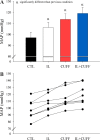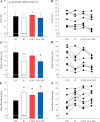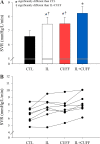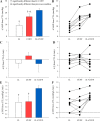Combined influence of inspiratory loading and locomotor subsystolic cuff inflation on cardiovascular responses during submaximal exercise
- PMID: 32240016
- PMCID: PMC7272751
- DOI: 10.1152/japplphysiol.00781.2019
Combined influence of inspiratory loading and locomotor subsystolic cuff inflation on cardiovascular responses during submaximal exercise
Abstract
It is unknown if simultaneous stimulation of the respiratory and locomotor muscle afferents via inspiratory loading (IL) and locomotor subsystolic cuff inflation (CUFF) influences the cardiovascular responses during exercise. We hypothesized that combined IL and CUFF (IL + CUFF) will result in greater increases in blood pressure (MAP) and systemic vascular resistance (SVR) than IL and CUFF alone during exercise. Eight adults (6 males/2 females) were enrolled and performed four 10-min bouts of constant-load cycling eliciting 40% maximal oxygen uptake on a single day. For each exercise bout, the first 5 min consisted of spontaneous breathing. The second 5 min consisted of voluntary hyperventilation (i.e., breathing frequency of 40 breaths/min) with IL (30% maximum inspiratory pressure), CUFF (80 mmHg), IL + CUFF, or no intervention (CTL) in randomized order. During exercise, cardiac output and MAP were determined via open-circuit acetylene wash-in and manual sphygmomanometry, respectively, and SVR was calculated. Across CTL, IL, CUFF, and IL + CUFF, MAP was greater with each condition (CTL: 97 ± 14; IL: 106 ± 13; CUFF: 114 ± 14; IL + CUFF: 119 ± 15 mmHg, all P < 0.02). Furthermore, SVR was greater with IL + CUFF compared with IL, CUFF, and CTL (CTL: 6.6 ± 1.1; IL: 7.5 ± 1.4; CUFF: 7.5 ± 1.3; IL + CUFF: 8.2 ± 1.4 mmHg·L-1·min-1, all P < 0.02). Cardiac output was not different across conditions (CTL: 15.2 ± 3.8; IL: 14.8 ± 3.7; CUFF: 15.6 ± 3.5; IL + CUFF: 14.7 ± 4.3 L/min, all P > 0.05). These data demonstrate that simultaneous stimulation of respiratory and locomotor muscle afferent feedback results in additive MAP and SVR responses than IL and CUFF alone during submaximal exercise. These findings have important clinical implications for populations with exaggerated locomotor and respiratory muscle reflex feedbacks.NEW & NOTEWORTHY Reflexes arising from the respiratory and locomotor muscles influence cardiovascular regulation during exercise. However, it is unclear how the respiratory and locomotor muscle reflexes interact when simultaneously stimulated. Herein, we demonstrate that stimulation of the respiratory and locomotor muscle reflexes yielded additive cardiovascular responses during submaximal exercise.
Keywords: blood pressure; cardiac output; exercise pressor reflex; respiratory muscle metaboreflex; venous distention.
Conflict of interest statement
No conflicts of interest, financial or otherwise, are declared by the authors.
Figures




Similar articles
-
Influence of locomotor muscle group III/IV afferents on cardiovascular and ventilatory responses in human heart failure during submaximal exercise.J Appl Physiol (1985). 2022 Apr 1;132(4):903-914. doi: 10.1152/japplphysiol.00371.2021. Epub 2022 Feb 24. J Appl Physiol (1985). 2022. PMID: 35201931 Free PMC article.
-
Influence of menopause status and age on integrated central and peripheral hemodynamic responses to subsystolic cuffing during submaximal exercise.Am J Physiol Heart Circ Physiol. 2016 Dec 1;311(6):H1382-H1391. doi: 10.1152/ajpheart.00310.2016. Epub 2016 Oct 7. Am J Physiol Heart Circ Physiol. 2016. PMID: 27765745 Free PMC article.
-
Effect of increased inspiratory muscle work on blood flow to inactive and active limbs during submaximal dynamic exercise.Exp Physiol. 2019 Feb;104(2):180-188. doi: 10.1113/EP087380. Epub 2018 Dec 9. Exp Physiol. 2019. PMID: 30462876
-
The hyperpnoea of exercise in health: Respiratory influences on neurovascular control.Exp Physiol. 2020 Dec;105(12):1984-1989. doi: 10.1113/EP088103. Epub 2020 Mar 16. Exp Physiol. 2020. PMID: 32034952 Review.
-
Consequences of group III/IV afferent feedback and respiratory muscle work on exercise tolerance in heart failure with reduced ejection fraction.Exp Physiol. 2023 Nov;108(11):1351-1365. doi: 10.1113/EP090755. Epub 2023 Sep 21. Exp Physiol. 2023. PMID: 37735814 Free PMC article. Review.
References
Publication types
MeSH terms
Grants and funding
LinkOut - more resources
Full Text Sources
Miscellaneous

